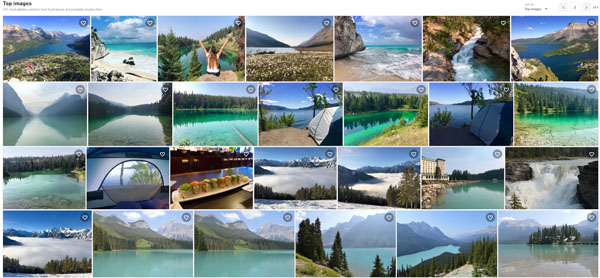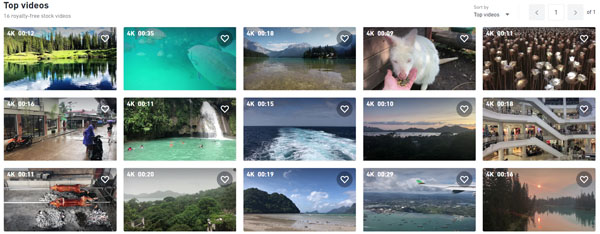Did you know that you can make extra money on the side by selling photos and videos taken with your phone?
If you are already uploading your photos and videos on Instagram and YouTube, you have a lot of content that you can start selling right away.
You don’t need to have any special equipment or be a professional photographer to make some extra money with your photos and videos.
In fact, some of the photos that generated the most revenue for me were shot with my older iPhone 5.
There are many people making a passive side income from their stock photo and footage portfolios.
What are Stock Images?
Stock images are high-quality photos of places, nature, food, people, or social behaviors that are licensed to be used for various commercial and non-commercial purposes.
The images that you see on most blogs and websites are stock images.
There are millions of different niches on the internet so almost any high-quality image can be potentially sold.
Here is my stock image portfolio:

What is Stock Footage?
Stock footage are short 7 to 60-second video clips that are licensed in the same way as stock images. There is no background sound or music in stock footage.
There are different types of licenses but in most cases, you keep the right to your photos and videos even after you get paid for it.
Here is my stock footage portfolio:

Why Would Anyone Pay For Your Photos and Videos?
There are many stock media agencies that sell photos and videos to news agencies, brands, marketing/entertainment agencies, and Youtubers.
These stock websites license your photos and videos and pay you a commission each time someone downloads your content.
This benefits both a content creator (you) and a person using your media (ex. news agency).
You get a commission and the person using your media files doesn’t have to go and shot photos or videos himself.
How Stock Photos and Videos are Used?
Let’s say you are traveling to Banff and you take a picture or video of Lake Louise with your iPhone 8.
After you get home, you upload your clips and photos to a stock agency.
In a few months, someone in Australia decides to create a YouTube documentary about Banff.
He wants to show the most beautiful places in Banff and he needs a video of Lake Louise to complete his documentary.
There are two options to obtain the footage of Lake Louise:
- Spend several thousands of dollars to travel to Canada and shot a video of Lake Louise.
- Go to a stock footage website and pay $179 for the footage of the Lake Louise that you shot.
What is the most economical solution in this case?
Obviously purchasing a license to the video clip that you uploaded.
Basically this is how stock photo and video market works.
Contributors (people like you) submit their content and buyers pay for the license to use your content in their work.
Why Use Phone to Take Stock Photos and Videos?
The answer is simple – it is much more convenient than using a professional camera.
You always have your phone on you.
Carrying a big camera is not convenient and it costs money to buy one.
Yes, you will get more sales if you use a professional camera to shoot photos and videos but it requires more effort.
With your smartphone, you can take photos and videos everywhere you go.
Besides, most modern phones can take incredible high definition photos and videos.
My top earning photo was taken with my older iPhone 5 (the image below)

I am still not sure why the buyer wanted my low definition image instead of hundreds of other photos shot with professional cameras.
You heard the saying that quality is more important than quantity.
However, when selling stock footage and images, quantity is equally important.
On many occasions, the content of your media files will be more important to the buyers than the professional quality.
Yes, you can spend half an hour editing each piece of your content in Photoshop but it is unlikely that the extra time that you spend will pay off in incremental increase in earnings.
Nothing wrong with doing some retouching on your photos and videos as long as you can do it fast.
I guess the lesson here is not to worry about being perfect and instead be consistent with taking photos or videos and uploading them to build a bigger portfolio.
With practice, you will learn what sells and the quality of your content will improve.
What Photos and Videos Should You Take?
It is important to keep in mind the commercial value of your content.
How can buyers use your photos or videos to sell products or services?
Whenever shooting set your camera to the highest definition.
Minimum requirements for most stock agencies are usually 4 megapixels for images and 1080p for video.
If you have a newer phone, you should be able to do much better than that.
Make your photos at least 12 megapixels and videos 4K.
This will get you more sales and you will be able to charge more for higher quality content.
There are many devices that can play 4K videos and by shooting in 4K you will increase the shelf life of your content and it will continue to bring you money for years to come.
With stock footage, it is preferable to avoid any shakiness in your videos.
Most phones are already stabilized but try to keep your hands steady when taking videos or even better use the tripod.
Model and property releases – if you take photos or videos with recognizable people or private property you will need to have a signed release form before you can upload your content.
Avoid taking any photos that include brand names, logos, or any type of artistic work.
These images can’t be used for any commercial projects because of the copyright laws.
There are two types of stock images and videos that are sold online: commercial and editorial.
What Is the Difference Between Commercial and Editorial Content?
1. Commercial photos and video footage
This content can be used for any purpose.
This means if there is a recognizable person or private property you need to have a release form to sell it as commercial content.
Commercial content cannot contain any logos, brand names, or any other third party intellectual property.
Below is an example of commercial stock image:

2. Editorial photos and video footage
This content cannot be used to sell any products and be monetized.
It can only be used in news stories where the main goal is to inform or educate and not to sell anything.
You can still make money with editorial content but it will not sell as well as commercial.
Below is an example of editorial stock image:

Where to Sell Your Photos and Videos?
There are dozens of different stock agencies where you can sell your content.
There are many different photo and video selling apps as well.
However, it takes time to upload your content to every agency so to be more efficient I like to focus on the big players.
1. Shutterstock
Shutterstock is the biggest and best performing agency.
If you only want to upload your content to one agency, go with Shutterstock.
They even have an app that you can download to your phone which allows you to upload your content directly from the phone.
How much Shutterstock pays for images and videos?
Shutterstock has a tiered earning system.
Basically you will start with $0.25 per photo download and as your lifetime earnings increase your rate per standard image download will increase up to $0.38.
This is how much you get paid if a person who downloads your photo has a subscription with Shutterstock.
If they don’t, you get paid more.
There are also different types of licenses for each image and if the buyer goes with Enhanced license you will get paid much more than $0.25 per download.
I heard that some people are getting up to $120 for some of their images.
The highest I ever got for a single image download was $19.
For the videos you cut will be 30% of the sale price.
Most 4K clips are sold at $179.
So you will be getting around $54 from each video sale ($179×0.3).
That’s a lot of money for a 20-second video shot with your iPhone.
2. Pond5
Pond5 is another great agency to sell your 4K stock footage.
Their prices for footage are lower so you will likely get more sales there.
You can also sell images there but I didn’t have much luck.
Pond5 pays 40% commission for non-exclusive video contributors and 60% for exclusive.
I like to sell my video clips on various platforms so I submit mine as a non-exclusive contributor.
However, if you want to submit your videos to only one agency, it might be worth going with exclusive license to increase your cut to 60%.
3. Adobe Stock
Another big platform to submit both photos and videos.
They pay between $0.33 and $0.38 for standard image download depending on the earning tier.
Similarly to Shutterstock you get paid more if the buyer doesn’t have a subscription with Adobe or gets an extended license.
Commission for videos is 30% which works out to be around $70 for every 4K clip.
What Pictures and Videos Sell the Best?

When taking pictures and shooting footage with your phone that you are planning to sell it is important to think about how your work can be used on websites, ads, or in movies.
Not every picture or video will attract clients.
There is quite a bit of competition because anyone with a phone can create content.
To stand out try to choose a niche for yourself.
There are already a lot of photos and videos of things like the sky, clouds, sunsets, grass and etc.
Below are ideas for the content that sells pretty well on stock agency websites:
- Photos of people. Some examples are people working, doing everyday things, eating, talking on the phone, or even sleeping. When you take a picture of a person they will need to sign a model release form which gives you the rights to sell the photo. If a person can’t be recognized in the picture (face is not shown), you don’t need a release form.
- Food and drinks.
- Animals
- Industrial and transportation
- Travel photos and videos
- Shoot content related to current events, trends, and upcoming holidays. You can use Google Trends to find what is trending right now.
How to Start Selling Your Images and Videos?

The first step is to join a few stock agencies.
I recommend joining Shutterstock, Pond5, and Adobe.
Select 20 of your best photos and submit them to these 3 agencies.
You probably already have a lot of older photos and videos that you can submit.
To get accepted only submit your best work first and ensure that your photos don’t have any logos or recognizable buildings and people.
Photos with intellectual property get rejected unless you have the release forms.
Other reasons why photos get rejected by stock agencies are poor focus and blurriness.
If you don’t get accepted, you can try submitting your photos again after a few weeks.
For each submission, you will need to add a title describing the content of each image and clip.
It is important to be as descriptive as possible in your titles. Also, add all the relevant keywords.
Both keywords and titles are used by the search algorithm.
The closer your title and keywords are related to what the buyer is searching the higher your content will show up in search results and more chances it will have to be sold.
Use the Keyword Suggestion Tool from Shutterstock to come up with keywords.
I highly recommend visiting the website of each agency and see what images and footage people sell to get a better feel on what you should be shooting.
To increase your chances of getting accepted by stock agencies read this article on the Shutterstock website.
It talks about best practices when it comes to photo and video submissions.
After you get accepted, start uploading your photos and videos.
Accepted content can be licensed to hundreds of buyer and it will continue to bring you income year after year.
You will likely not get sales right away and instead focus on building a large portfolio of stock images and footage.
Thinks about your stock and video portfolio as your savings account.
Each month it will generate revenue for you and the bigger your portfolio the higher will be the earnings per month.
It is important to keep your expectations in check.
It is unlikely that you will be able to quit your day job with your income from stock content, but if you build a large portfolio it can become your significant source of extra income.
Why not submit your images to more agencies?
You can but it will take time and with smaller agencies, the time you spend uploading your content might not worth the extra money that you will make.
Should You Edit Your Photos and Video Footage Before Selling It?

If you are good at Photoshop and can edit your photos fast, go ahead and retouch them.
But if you don’t have Photoshop and have no idea how to edit photos just upload unedited images and then learn along the way.
You will need to cut your videos in small 7 to 60 second clips and remove sound before uploading them.
Similarly to photos you can use specially designed video editing software to retouch your clips and make them more appealing to buyers.
However, if your goal is to save time, you can use iMovie app on your phone and do all the edits there.
I used to do it on the way to work to save time.
Selling stock images and footage is not my main source of income so my personal goal is to spend as little time as possible on the entire process from shooting to uploading to stock agencies.
If you want to go more in-depth with stock footage and photos, you can later switch to a professional camera and buy a better editing software.
There are also various courses that you can take online to improve your skills.
Conclusion
You are not going to become a millionaire by selling photos and videos taken with your phone but it can be a good side income.
All you have to do is to find some older photos and videos or shot new content and upload it to a few stock agencies.
If you continue to upload new content a few times per month you will be able to build a large portfolio that can become a good revenue source.
Try it today. Don’t let your older content sit on your phone without generating any income for you.
Did you know that your internet service provider can track your online activity? Want to hide your identity online and keep your browsing habits private? Try NordVPN!
*This post might contain affiliate links. If you click on a link, I might receive a small commission.

